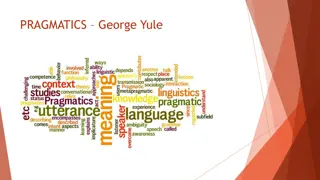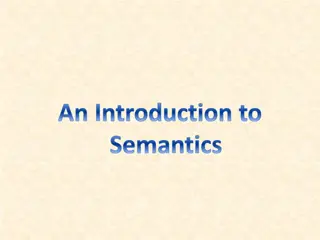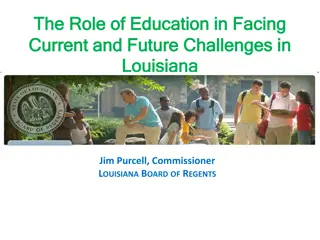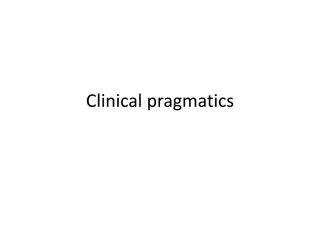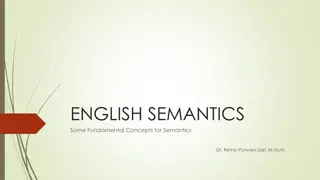Understanding Language: An Overview of Linguistics
Linguistics is the scientific study of language, a complex system of sounds, words, and patterns that humans use to communicate thoughts and feelings. Language consists of phonology (sounds), morphology (words), syntax (sentences), semantics (meaning), and pragmatics (contextual meaning). Different
0 views • 42 slides
Exploring Pragmatics in Linguistics Studies
Pragmatics delves into the study of implied meanings and how we interpret language in various contexts. It focuses on understanding communication beyond explicit words and explores the invisible meanings conveyed through situational and linguistic contexts. Deixis, physical context, and linguistic c
0 views • 41 slides
Understanding Discourse Structure in Linguistics
Pragmatics explores the relationship between language and the world, while discourse is seen as an interactive totality. Rank structures, as in linguistics, help analyze the grammar of sentences. The Birmingham School of Discourse Analysis pioneered influential studies in this field, focusing on sch
1 views • 29 slides
Understanding Linguistics: An Overview of Language Study
Linguistics is the scientific study of human language systems, encompassing phonetics, syntax, semantics, phonology, pragmatics, and morphology. It explores how language functions, aids in language teaching, and facilitates error analysis. The scope of linguistics includes investigating sound system
1 views • 21 slides
Overview of Micro and Macro Linguistics
Micro linguistics focuses on the scientific study of speech sounds, word formation, syntax, and meaning within a language, while macro linguistics delves into the societal, psychological, and neurological aspects of language use. Micro linguistic areas include phonetics, phonology, morphology, synta
1 views • 7 slides
Overview of Pragmatics and Deixis According to George Yule
Pragmatics and Deixis are crucial aspects of language understanding, as explored by George Yule. Pragmatics focuses on the use of language in context, while Deixis involves pointing via language to convey meaning based on the immediate context. Deictic expressions play a significant role in face-to-
0 views • 19 slides
Understanding Semantics and Pragmatics in Language Study
Semantics and pragmatics are key areas of language study that focus on the meanings of words, phrases, and sentences. Semantics delves into the literal meanings and language as a system, while pragmatics explores how speakers use language in context. Understanding semantic meaning involves consideri
3 views • 77 slides
An Exploration of Linguistic Meaning: Semantics and Pragmatics
Delve into the realm of linguistic meaning through the lenses of semantics and pragmatics. Explore how words and phrases carry literal meanings, while language usage in social contexts creates both literal and nonliteral meanings. Uncover the intricate interplay between semantics, concerned with the
6 views • 70 slides
Understanding Semantics: The Study of Meaning in Language
Semantics is the branch of linguistics focusing on meaning, exploring how words, sentences, and symbols convey and represent ideas. It is crucial for language acquisition, change, social contexts, and linguistic analysis. Important aspects include symbol and referent relationships, denotation, conno
0 views • 19 slides
Understanding Semantic Relations in Language
In semantics and pragmatics, sense relations are categorized into paradigmatic, syntagmatic, and derivational axes. Paradigmatic relations involve semantic choices within a sentence structure, while syntagmatic relations connect items within the same sentence. Examples include synonymy, hyponymy, me
0 views • 33 slides
Understanding Implicature in Pragmatics
Explore the concept of implicature in pragmatics, distinguishing it from entailment, identifying types of implicatures, and understanding how implicatures are context-dependent and cancellable. Delve into examples and implications of implicature in communication.
0 views • 28 slides
Speech and Language Developmental Milestones: A Bilingual/Multilingual Perspective
Speech and language developmental milestones are crucial for children, regardless of their home language. These milestones encompass receptive language, expressive language, pragmatics, and articulation and phonology. Understanding how a child hears and talks from birth to one year is essential, as
1 views • 23 slides
An Exploration of Semantics and Pragmatics: Classical vs. Prototype Approach
Delve into the world of semantics and pragmatics through an examination of the classical and prototype approaches to defining categories. From Aristotle's sharp boundaries to Rosch's fuzzy categories, uncover the complexities and limitations of language structure and meaning.
0 views • 22 slides
Understanding Speech Act Theory and Pragmatics Tutorial
Dive into the intricacies of speech act theory with a focus on direct and indirect speech acts, illocutionary and perlocutionary forces, and performative verbs. Explore various linguistic forms including interrogative and declarative structures to understand how language can be used to convey intent
0 views • 35 slides
Understanding the Fundamentals of Linguistics: A Visual Overview
Explore the key elements of language, from phonetics and phonology to morphology, syntax, semantics, and pragmatics. Delve into the study of individual speech sounds, word structure, and the rules governing sentence structure. Discover how meaning is conveyed through words and sentences, and how con
0 views • 16 slides
Introduction to Meaning in Language: Semantics & Pragmatics
Meaning in language is explored in this introductory lecture, covering aspects such as communication, semiotics, linguistic channels, and approaches to studying meaning. The process of encoding messages, signal transmission, noise interference, and decoding are discussed within the context of commun
0 views • 19 slides
Understanding Semantics and Pragmatics: Exploring Extensions of Meaning
This chapter delves into the realms of semantics and pragmatics, exploring literal and non-literal meanings, naturalized, established, and nonce extensions, as well as metaphor and metonymy. It discusses how certain meanings become entrenched in language, either as naturalized or established extensi
0 views • 18 slides
Understanding Pragmatics in Communication
Pragmatics in communication involves recognizing not just the literal meaning of words, but also understanding the speaker's intentions and context. It delves into invisible meanings, shared assumptions, and expectations that shape communication. This includes linguistic and physical context, deixis
0 views • 13 slides
Understanding Computational Linguistics: Pragmatics and Formalisms
Explore the world of computational linguistics through topics like pragmatics, formalisms, knowledge representation, state machines, neural models, semantics, and discourse analysis. Dive into the intricacies of language structures, meanings, and contextual inferences to unravel the complexities of
0 views • 64 slides
Understanding Pragmatics: The Study of Language in Social Interaction
Pragmatics, a subfield of linguistics, focuses on the factors influencing language choice in social contexts. It differentiates between semantic and pragmatic information, emphasizing the relationship between language use, context, and the effects on communication. The study of pragmatics delves int
0 views • 20 slides
Understanding Pragmatics in Language Analysis
Pragmatics in language analysis involves studying utterance meaning beyond semantics, focusing on context-dependence, complete context-dependence, and pragmatic knowledge. Basic concepts include semantics, discourse, Grice's Relevance Theory, Speech Acts, Metaphor Theory, and more. Truth-conditional
0 views • 47 slides
Understanding Discourse Analysis: A Comprehensive Overview
Discourse analysis involves the study of language usage in different contexts, encompassing various aspects such as applied linguistics, rhetoric, and pragmatics. It aims to uncover how meanings are created, challenged, and changed through communication. By analyzing discourse, we can gain insights
0 views • 41 slides
Education's Role in Facing Current and Future Challenges in Louisiana
Louisiana's public colleges and universities play a crucial role in addressing the challenges faced by the state. Commissioner Jim Purcell emphasizes the importance of education in overcoming current and future obstacles. Conversations about education, the pragmatics of the workplace, and historical
0 views • 79 slides
Understanding Pragmatics in Speech and Communication
Explore the world of clinical pragmatics, speech acts, direct vs. indirect speech acts, and the works of Austin and Searle in understanding how language goes beyond semantics. Delve into felicity conditions and conventions that govern effective communication and learn about assessing pragmatic skill
0 views • 52 slides
Language Frameworks and Analysis Basics for English Revision
This content provides a comprehensive overview of language frameworks for English revision, including analyzing text using GRASP method, understanding main language frameworks like lexis, semantics, grammar, phonology, pragmatics, graphology, and discourse, and details on word classes like nouns, ad
0 views • 17 slides
Fundamentals of English Semantics: Key Concepts and Theories
English Semantics explores the study of meaning in human language, focusing on compositional characteristics and significantly underspecified meanings. It delves into the interconnected branches of linguistics, including phonetics, phonology, morphology, syntax, semantics, and pragmatics, each playi
0 views • 13 slides
Exploring Lexical Variation in Landscape Descriptions
Focused on studying lexical variation in landscape descriptions, this subgroup aims to enhance coordination, develop specific actions, and seek technical solutions within WG4. By analyzing words related to landscape, colors, and emotions, the group investigates conventionalized changes, lexically di
0 views • 22 slides
Understanding Language Properties and Definitions
Language is defined by its unique properties such as rapid fading, interchangeability, feedback, semanticity, arbitrariness, discreteness, displacement, productivity, cultural transmission, duality, prevarication, reflexiveness, and learnability. These properties help distinguish human language from
0 views • 19 slides
Understanding Semiotics and Multimodality in Communication
Exploring the realm of semiotics and multimodality, this study delves into the use of multiple semiotic modes in communication. It discusses the significance of combining different modes like verbal, visual, and aural symbols to convey messages effectively. The concept of multimodal texts and their
0 views • 19 slides
Introduction to Semantics and Pragmatics: Understanding Meaning in Language
This lecture delves into the fundamental concepts of semantics and pragmatics, exploring the distinction between extension and intension in language meaning. It discusses the relationships between words, the world, and other linguistic elements, emphasizing the importance of sense, denotation, and r
0 views • 13 slides





